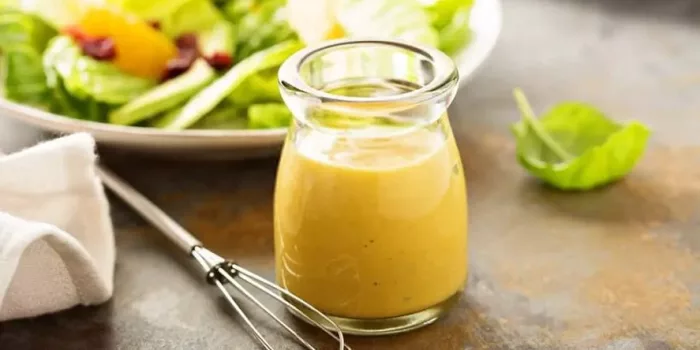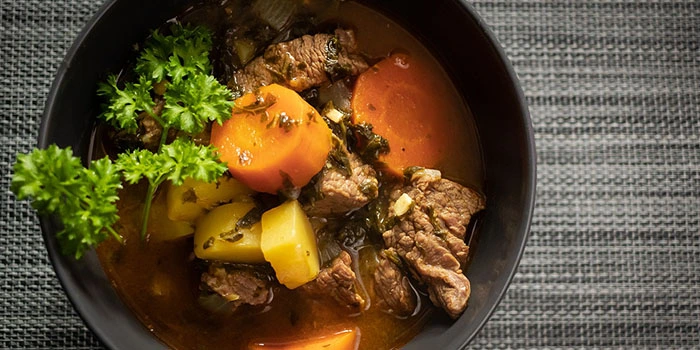The fragrant salad dressing is an integral part of this dish. They could be sweet and salty, sour and spicy, but the main property that unites this group of liquid seasonings is a thick, often homogeneous, consistency.
The gravy may not be homogeneous and viscous depending on the products and liquids used. In order to correct the seasoning in time, it is important to know a few culinary secrets: how to thicken salad dressing without spoiling the taste of the finished product.
Since each gravy differs not only in taste but also in different components, thickening methods can also vary. In some cases starch will be the most suitable product, in other cases, another product will have to be used. To choose the right component for a particular type of sauce, you should know a few simple product compatibility and quality rules.
If you are interested in having something tastier than usual commercial salad dressings, continue reading this article to learn how to get your homemade salad dressing to a desired consistency and stop consuming store-bought salad dressing

To thicken salad dressing, you can try the following methods:
Use more oil or reduce the amount of liquid
Increase the amount of oil in the salad dressing, which will make it thicker.
Cook the salad dressing on low heat for longer to evaporate some of the liquid and make it thicker.
Add ingredients
Try adding solid ingredients (or any type of thick dairy product – these have high nutritional value, as well) such as mayonnaise, yogurt, sour cream, or cream cheese to make the salad dressing thicker.
If you like to add fruits and vegetables to your salad dressing, puree them and then combine them with your salad dressing.
List the best fruits and vegetable choices to choose from.
Chill
Place the salad dressing in the refrigerator to allow it to thicken naturally.
Remember, to avoid altering the taste and consistency of your homemade salad dressing, always make small adjustments and mix thoroughly after each addition.

Use a thickening agent to thicken salad dressing
The use of thickening agents may be the most commonly used method to make a thick salad dressing. It is primarily used in salad dressing recipes and helps to stabilize existing emulsions. The thickener adds texture to a salad dressing – many add nutritional value, too!
Mix in a small amount of cornstarch or arrowroot powder, which will act as a thickener for your homemade salad dressing.
Blend the dressing instead of shaking or stirring it
Vinegar and oils, unlike egg yolk, do not have the ability to naturally mix.
Slowly add in some vinegar and oil and mix them together so that each layer stays separated. Vinegar at the bottom and oil at the top (similar to oil and balsamic vinegar mixtures in an Italian restaurant with free bread).
Agitations will combine both layers (known as emulsification), and will break down with time.
Emulsifying a salad dressing adds a creamy consistency to a dish that thickens. The more agitating the mixture is, the thicker and creamy it is and the longer each ingredient stays together.
Shaking is the least intense form, followed by intense whisking, followed by mixing of egg yolk with lemon juice if necessary.
Add the oil slowly to the vinegar
Salad dressing contains mixtures of oils soaked in vinegar or other astringent substances. These are very small oil particles coated in vinegar. The thickest emulsion can easily be obtained by mixing olive oil with vinegar (not exactly the opposite!).
Add oil slowly to smaller batches will ensure that the particles are as small as possible to mix, creating an incredibly smooth and thick salad dressing.

Thicker for Longer
Several commonly available vinaigrette ingredients help you to separate oils from vinegar while allowing you to retain the creamy texture of a homemade salad dressing.
Some common ingredients like prepared mustard, maple syrup, and honey – usually combined with others – and exotic products like Tahini are also included. It works partly because they are thicker than vinaigrettes, which simply spread over dressings making this rich and thick.
Mustard and sour garlic also act as mild emulsifiers that aid in bonding oil and liquid molecules. The thick dressing will eventually separate but may take hours or even days to achieve it.
How to thicken salad dressing with corn starch
Corn starches make a great thickener to salad dressing as they lack a sour taste if cooked correctly and we all carry these in our pantry. Cornstarch has thickening properties that require heat.
This should make salad dressing thicker quickly: a teaspoon of cornstarch slurry thickens a cup of fluid. Remember it is necessary to include cornstarch in a dressing.
Avoid too many ingredients in a single day.
Both anthocyanin and Guar Gum can be good for thickening salad dressings. Both gums have been used for many years by restaurants and salad dressing companies.
How to thicken salad dressing with flax or chia seeds
To thicken salad dressing with flax seeds or chia seeds, you can grind the flax seeds/chia seeds into a fine powder using a coffee grinder or a blender, and then mix the ground flax seeds (would be better if they were ground seeds) into your dressing. Start by using one tablespoon of flax seeds/chia seeds per ¼ cup of dressing, and adjust as needed.
Let the mixture sit for 5-10 minutes to allow the flax seeds/chia seeds to absorb the liquid and thicken the dressing.
Whole flax seeds have sluggish effects when combined with water. The gelling action thickens salad dressing instantly.
This will give the salad a mild and creamy taste. For optimal nutrition use ground seeds. Whole chia seeds can replace whole flax seeds. Chia seeds are smaller and can affect dressing textures in no way.

Add a thickening agent (also works for non-emulsion-based dressings)
I have talked much in this article but have forgotten dressings that don’t contain oil or acids. I’ll fix this soon, however.
Thickeners help dressings with any kind of ingredient. These will thicken the mixture, giving it a sweet consistency as well as stabilizing the present emulsions (although they may not always make good emulsification alone). Soy lecithin, for example, is a good alternative.
How many emulsifiers do I need to use?
Use a salad dressing emulsifier if necessary. A teaspoon of emulsifier will suffice. The addition does not hurt. Mixing emulsifiers will also not affect the body’s immune systems and you can try something new with your creativity!
There are several ingredients that can be used to thicken salad dressing, including:
Gelatin
Dissolve gelatin in a small amount of liquid and then slowly pour it into the dressing to thicken it.
Mashed avocado
Mashed avocado can be added to the dressing to thicken vinaigrette and add some natural thickening.
Starches (corn/tapioca/arrowroot)
Corn starch is a common ingredient with a thickening power and can be mixed with a small amount of cold water to create a slurry, which can then be stirred into the dressing. It also makes it easier to prepare salad dressings and sauces by adding some extra ingredients.
Arrowroot is another starch that can be used to thicken salad dressing, and it works similarly to cornstarch.
Gums (xanthan/guar)
Gum is commonly a salad dressing thickening agent and it is used in most salad dressings. They are not temperature sensitive and are ideal for cold dressing.
They are so powerful they are difficult to use at times. Adding excessive amounts can cause salads to become thick, sticky, and mushy. It’s horrifying.
A small quantity of xanthan gum can be added to the dressing to thicken it. Start with a pinch and gradually add more until you reach the desired consistency.
- NOTE: When using thickening agents, it is important to slowly pour them in small amounts, and then allow time for the dressing to thicken before adjusting the consistency further if necessary.
Adding a gum
Low-fat dressings can usually use guava or xanthan gum for reducing oil content. Use the gums for thickening in the following ways:
Xanthan gum, like other gelling agents, has been found by some people to increase their salad dressings to about 0.5%.
You should take 0.1-6.0% of dressing weight or in simple words 1/8 teaspoon per serving of liquid. Keep the correct ratio and don’t add anything! Additions can ruin textures if necessary. It may seem thin, but you could use an alternate thickener.
When you touch the liquid, the gum swells.
The powder clumping is immediately removed from the dressing so there is more gel to form.
The gums are coated with oil to prevent them from being used immediately. If we do not use oil, we could just have sugar powder instead.
- NOTE: It is quite complicated for people to use gum for thickening salad dressings because adding too much of gelling agents can ruin the flavor of salad dressings. The maximum amount of gum is 1/8 teaspoon in every serving of liquid.
How long will homemade mayonnaise last?
Homemade mayonnaise can be stored in ice-cold air for 3-5 days, as the lemon juice among the ingredients might go bad. Canning bottles can make great containers for the storage of homemade mayonnaise.

FAQ
How can I thicken my salad dressing without cornstarch?
Tapioca starch, commonly called tapioca flour, is a flour produced from cassava seeds. equivalent to ten tablespoons if you have two cups of tapioca flour. Tapioca starches help thicken sauces cooked in a pan.
How do you thicken cold dressing?
Dissolve the corn starch or any starch such as potatoes/potato starch with water. You can find a cloudy mixture called Slurry which works very nicely.
What is the best salad dressing thickener?
Corn starch is an incredibly effective thickener that will not alter the flavor and texture of your dressings. This ingredient has a long history in cupboards and is often seen in many recipes.
How can I thicken my ranch dressing?
Besides cornstarch, there are other alternatives. Tell me the answer. Blend cornstarches and equal parts of water together till they dissolve in the water and make a paste. Add a few drops of the mixture to a dish and add to ranch dressing.
Concluding words
Beware that the addition of ingredients to the salad dressing might reduce its shelf life, so be careful in choosing a stable emulsion or high-quality dairy products.
We hope that out of the above-listed ways to thicken salad dressings, you found the one that fits your style of cooking the most!





